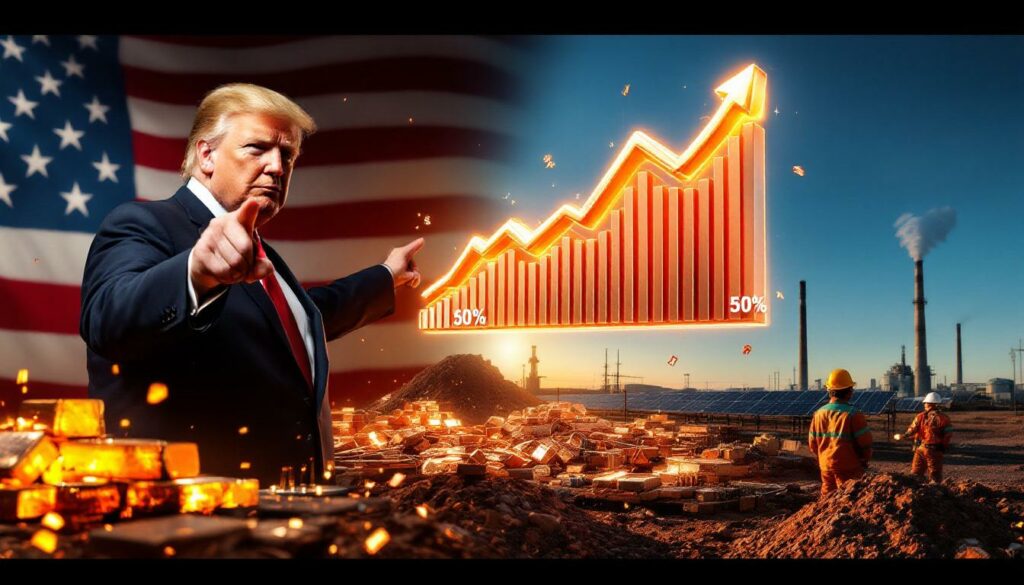Trump's 50% Copper Tariff: Market Impact Analysis
Trump's announcement of a 50% tariff on copper imports has sent shockwaves through global metals markets, creating both challenges and opportunities across various industries. With the August 1, 2025 implementation date approaching, stakeholders are scrambling to adapt their strategies and supply chains. This comprehensive analysis examines the far-reaching implications of this significant trade policy shift.
Understanding the Copper Tariff Announcement
The 50% tariff on copper imports represents one of the most aggressive trade actions in recent years. Announced earlier this year, the tariff applies to both raw copper and semi-finished products like cables and wiring components. The implementation date is set for August 1, 2025, giving importers a narrow window to adjust their supply chains.
Since February 2025, when Trump first suggested the possibility of copper tariffs, global traders have rushed record volumes of copper to U.S. ports to beat potential levies. This pre-emptive stockpiling created initial market distortions that are now evolving into longer-term structural adjustments.
"The spirit is to protect and facilitate local business," explained Maria Cristina Bifulco, Head of Investor Relations at Prysmian SpA, the world's largest cable manufacturer. While ostensibly designed to boost domestic production, industry experts remain divided on whether the tariff will achieve this goal without additional policy support.
Market Context: The copper tariff follows a pattern of protectionist trade measures aimed at revitalizing U.S. manufacturing and reducing dependence on foreign suppliers for critical metals and minerals.
Why Is the Copper Tariff Creating Market Disruption?
The announcement has triggered significant volatility in copper markets, with U.S. prices surging ahead of the tariff implementation. The premium for U.S.-delivered copper has widened dramatically compared to global benchmark prices, creating arbitrage opportunities but also challenging cost structures for manufacturers.
Import patterns have shifted dramatically—after the initial rush to beat tariffs, many buyers are now slashing imports and delaying orders. This whipsaw effect has created logistical challenges throughout the supply chain, with warehouses initially overflowing now preparing for potential shortages.
"We are better placed than other players," noted Bifulco, referring to Prysmian's strategic advantage in having established domestic sourcing relationships. Companies without such arrangements face much steeper challenges in maintaining competitive pricing.
Supply chain disruptions are particularly acute for:
- Electronics manufacturers reliant on high-purity copper
- Construction companies facing volatility in materials costs
- Smaller manufacturers without bargaining power with suppliers
- Renewable energy projects dependent on copper for transmission infrastructure
These disruptions highlight the interconnected nature of global metals markets and the cascading effects of trade policy changes on downstream industries.
How Are Different Industry Players Responding?
Cable Manufacturers See Strategic Opportunities
Major domestic cable producers are positioning themselves to benefit from the tariff landscape. Prysmian SpA, which acquired Texas-based Encore Wire Corp. for over $4 billion last year, views the tariff as reinforcing its market position.
With 220,000 metric tons of annual production capacity at its Dallas facility, Prysmian has established strong domestic supply relationships, particularly with Freeport-McMoRan Inc., one of America's largest copper producers. This vertical integration strategy appears prescient in the current environment.
"This will further reinforce the leadership of the local players," Bifulco stated, highlighting how established domestic manufacturers with secure supply chains gain competitive advantages when import barriers rise.
The company has successfully passed increased costs to customers thus far, though questions remain about how sustainable this approach will be if prices continue rising. Their ability to maintain margins while competitors struggle demonstrates how prepared companies can leverage disruption as opportunity.
Supply Chain Adaptations and Challenges
Companies across the value chain are implementing diverse strategies to mitigate tariff impacts:
-
Increased scrap utilization: Prysmian is exploring expanding its use of domestic copper scrap, potentially adopting refinement models similar to those used by European metal recycler Aurubis AG.
-
Material substitution: "Aluminum may substitute copper in some applications," Bifulco noted, though technical limitations restrict where this substitution is viable.
-
Supply contract renegotiations: Manufacturers are revisiting long-term agreements, seeking flexibility or domestic origin requirements.
-
Stockpile management: Companies that built inventories ahead of the tariff announcement are carefully managing drawdowns to optimize tariff-free supplies.
-
Production relocations: Some manufacturers are evaluating shifting copper-intensive production steps to facilities outside the U.S., then importing finished goods with lower tariff exposure.
These adaptations demonstrate the market's agility but also highlight inefficiencies introduced by rapid policy changes. Complete supply chain reorganization requires significant time and capital investment, creating transitional vulnerabilities.
What Are the Economic Implications?
Impact on US Manufacturing Costs
The tariffs create an immediate price premium for U.S. manufacturers that rely on copper inputs. Industry analysts warn that "consumers will have to pick up the tab" as these increased costs flow through to end products.
This cost pressure varies significantly by sector:
| Industry Sector | Copper Intensity | Ability to Pass Costs | Vulnerability |
|---|---|---|---|
| Electronics | High | Moderate | High |
| Construction | High | Variable | High |
| Automotive | Moderate | Limited | Moderate |
| Industrial Machinery | Moderate | Moderate | Moderate |
| Renewable Energy | Very High | Limited | Very High |
For export-oriented businesses, the cost increases present particular challenges, as international competitors without similar tariff burdens maintain lower production costs. This could potentially erode U.S. export competitiveness in copper-intensive products.
Domestic Production Realities
While boosting domestic copper production is a stated goal of the tariff policy, industry stakeholders remain skeptical about short-term supply expansion. Experts note that meaningful production increases "would take years and require additional incentives" beyond tariffs alone.
Key constraints on domestic expansion include:
- Permitting timelines: New mining projects typically require 7-10 years for approval
- Capital requirements: Developing new copper resources requires billions in investment
- Environmental regulations: U.S. mines face stringent requirements compared to some competing nations
- Infrastructure limitations: Processing capacity cannot be expanded overnight
- Geological factors: U.S. copper deposits often have lower grades than international alternatives
Industry Perspective: The U.S. currently lacks sufficient smelting and refining capacity to process significantly more domestic copper ore, creating bottlenecks that tariffs alone cannot resolve.
These realities suggest that while tariffs may incentivize investment, they cannot overcome fundamental structural limitations without complementary policies addressing permitting, infrastructure, and processing capacity.
Who Benefits and Who Loses?
Winners in the New Copper Landscape
Several key players stand to benefit from the tariff regime:
U.S. copper producers like Freeport-McMoRan and Rio Tinto will capture price premiums on domestically produced metal. Their established mining operations become significantly more profitable under tariff protection.
Domestic cable and wire manufacturers with secured supply chains, like Prysmian (via Encore Wire), gain competitive advantages over import-dependent rivals. Their vertical integration strategies provide insulation from the worst tariff impacts.
Recycling operations will see increased demand and improved economics as manufacturers seek tariff-free alternatives to imports. The U.S. copper scrap industry could experience significant growth as processing capacity expands.
Mining equipment suppliers may benefit from increased capital expenditure if producers invest in expanding domestic capacity, though this represents a longer-term opportunity.
Furthermore, ASX copper stocks have shown significant volatility as investors reassess their exposure to U.S. market disruptions and potential shifts in global trade flows.
Challenges for Copper-Dependent Industries
The tariff creates substantial headwinds for several sectors:
Electronics manufacturers face particular challenges due to their reliance on high-purity copper and tight margins in competitive consumer markets. Smaller producers without pricing power are especially vulnerable.
Construction firms must navigate volatile materials costs in an industry where contracts often lock in prices months before project completion. This creates margin pressure and complicates bidding processes.
Renewable energy developers confront increased costs for copper-intensive components like transmission equipment, potentially slowing deployment rates for solar and wind projects.
Small and medium manufacturers without established domestic supply relationships face disproportionate impacts, lacking both economies of scale and bargaining power to mitigate price increases.
What Should Investors and Businesses Watch?
Key Market Indicators to Monitor
For stakeholders navigating this changing landscape, several metrics provide crucial insights:
- U.S. vs. global copper price spreads: Widening premiums indicate supply constraints and arbitrage opportunities
- Import volume trends: Declining volumes may signal market adjustment or potential shortages
- Warehouse inventory levels: Drawdowns may precede price spikes or supply disruptions
- Substitution rates: Increasing aluminum usage in traditionally copper applications signals adaptation
- Scrap price movements: Rising scrap values indicate stronger domestic recycling demand
- Capital expenditure announcements: New investments reveal producers' confidence in tariff durability
"Assess whether demand is resilient enough" to absorb higher prices, advises Prysmian's Bifulco, highlighting the importance of monitoring end-user markets for signs of demand destruction or substitution.
Analysts are also closely watching copper price predictions from industry leaders to gauge long-term market expectations beyond the immediate tariff impact.
Strategic Considerations for Businesses
Companies across the value chain must evaluate several strategic options:
Supply contract renegotiations offer opportunities to reset terms in light of new market realities. Flexible pricing mechanisms and origin requirements may protect margins.
Hedging strategies become increasingly important in volatile markets. Forward contracts, options, and other financial instruments can provide price certainty amid fluctuations.
Material substitution feasibility varies by application. Engineering teams should systematically assess where aluminum or other alternatives can replace copper without compromising performance.
Reshoring calculations require fresh analysis. The tariff significantly shifts the economics of domestic vs. offshore production for copper-intensive manufacturing.
In addition, businesses are increasingly exploring copper investment strategies to hedge against supply chain disruptions and potentially benefit from price volatility.
FAQ: Trump's 50% Copper Tariff Impact
How will the 50% copper tariff affect consumer prices?
The tariff will likely increase consumer prices across multiple categories, with analysts warning that "consumers will have to pick up the tab." The impact will vary significantly by product:
- Electronics: Modest price increases as copper represents a smaller portion of total costs
- Home construction: Potentially significant impacts on electrical wiring costs
- Appliances: Moderate price increases, particularly for motor-driven products
- Automotive vehicles: Minor impacts on conventional vehicles, potentially larger for electric models with more copper content
Disclaimer: Price impact projections involve multiple variables beyond the tariff alone, including market adaptation, substitution rates, and overall economic conditions.
Will the tariff achieve its goal of boosting US copper production?
Industry stakeholders remain divided on this question. Many experts believe meaningful production increases "would take years and require additional incentives" beyond tariffs alone.
Key challenges include:
- Permitting timelines for new mines often exceed 7-10 years
- Existing operations have limited expansion capacity without major capital investment
- U.S. processing capacity (smelting/refining) represents a bottleneck
- Environmental regulations increase development costs relative to international competitors
While the tariff may improve project economics, it addresses only one of several constraints limiting domestic production growth.
The policy must also be viewed in the context of global copper supply trends, where significant new production is coming online in countries like Chile, Peru, and the Democratic Republic of Congo.
What alternatives exist for manufacturers facing higher copper costs?
Manufacturers are exploring several alternatives:
-
Material substitution: Aluminum can replace copper in some applications, particularly where weight is less critical than cost. However, technical limitations prevent substitution in many high-performance applications.
-
Design modifications: Reducing copper content through engineering innovations can mitigate cost impacts. This might include thinner conductors where appropriate or alternative architectures.
-
Supply chain restructuring: Some manufacturers may relocate copper-intensive production steps outside the U.S., then import finished goods with different tariff classifications.
-
Increased recycling: Expanding use of domestic scrap reduces exposure to import tariffs while potentially lowering overall material costs.
Conclusion: Navigating the New Copper Landscape
Trump's 50% copper tariff represents a significant shift in U.S. trade policy with far-reaching implications across multiple industries. While creating challenges for many copper consumers, it also presents strategic opportunities for domestic producers and companies with established supply chains.
The full impact will unfold over time as markets adjust, supply chains reconfigure, and investment decisions respond to new economic incentives. Successful navigation of this changing landscape requires careful monitoring of market indicators, strategic flexibility, and thorough understanding of both technical and commercial alternatives.
For investors, the tariff creates potential opportunities in domestic copper producers, recycling operations, and manufacturers with secured supply chains. However, these opportunities must be weighed against broader market uncertainties and the possibility of policy changes affecting tariff implementation or enforcement.
Moreover, the tariff comes at a time of rising copper demand driven by electrification trends, creating a complex interplay between policy-induced supply constraints and structural demand growth.
Disclaimer: This analysis represents current market understanding based on announced policies. Implementation details, potential exemptions, or policy modifications may alter actual impacts. Companies should consult trade experts for guidance on their specific situations.
Want to Spot the Next Major Mineral Discovery?
Discovery Alert's proprietary Discovery IQ model instantly notifies investors of significant ASX mineral discoveries, turning complex geological data into actionable investment opportunities before the broader market catches on. Explore why major mineral discoveries can lead to exceptional returns by visiting our dedicated discoveries page and start your 30-day free trial today.




